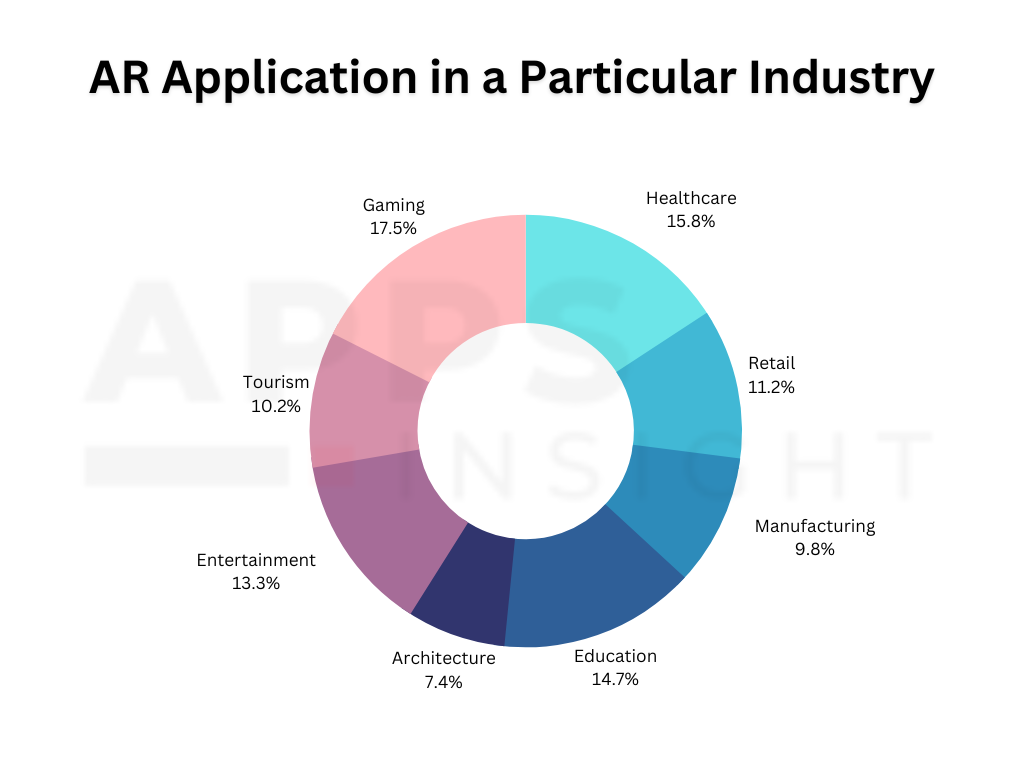Embarking on the journey of augmented reality app development in 2024? Prepare to dive into a universe where digital and real-world elements blend seamlessly, creating mesmerizing experiences. But as enchanting as this world is, the question that perplexes many is – “What’s the price tag for crafting such an immersive realm?”
The AR landscape has undergone significant evolution, making the development process a complex, multifaceted endeavour. It’s no longer just about slapping on some cool graphics; it’s about building intricate layers of interactivity and personalization. This makes the cost of AR app development a dynamic entity, influenced by myriad factors ranging from design complexity to technological integrations.
So, how much should you budget for your AR app development in 2024? Strap in as we delve deep into the nitty-gritty of the costs associated with AR development. As a bonus, we’ll even take a detour into the intriguing realm of the Metaverse, providing insights into the Metaverse Development Cost in 2024 – a concept that’s shaping the next frontier of digital interaction.
Augmented Reality Trends of 2024
- Increased Adoption of AR in eCommerce: AR in eCommerce projected to generate $120 billion in revenue, accounting for 12% of total eCommerce sales. (Source: MobiDev)
- AR-powered Remote Assistance: 70% of field service organizations expected to use AR for remote assistance, resulting in a 30% reduction in service resolution time. (Source: MobiDev)
- AR in Industrial Training and Maintenance: 55% of manufacturers anticipated to use AR for training and 45% for equipment maintenance, leading to a 35% reduction in training time and a 25% decrease in equipment downtime. (Source: MobiDev)
- AR for Social Media Engagement: 85% of social media users predicted to regularly engage with AR content, resulting in a 40% increase in time spent on social media platforms. (Source: MobiDev)
- Advancements in AR Cloud Technology: AR cloud platforms expected to handle over 3 billion daily active users, enabling seamless AR interactions in gaming, navigation, and social networking. (Source: MobiDev)
Basics of Augmented Reality
Before we delve into the costs, let’s quickly get a grasp of what AR is all about. Augmented Reality enhances our perception of the real world by overlaying digital elements like images, sounds, and sensations. From games like Pokémon Go to applications like IKEA Place that let you visualize furniture in your room, AR is changing the way we interact with the world.
Factors Influencing the Augmented Reality App Development Cost
AR app development is a complex and multifaceted endeavor, with the cost being influenced by various factors. Let’s break them down:
1. Complexity of the App Design
The design complexity directly impacts the development cost. Simple AR apps, like those offering basic image recognition, will cost less compared to advanced AR apps that incorporate 3D modeling, real-time tracking, or interactive elements.
2. Choice of Platform
Whether you’re developing your AR app for iOS, Android, or both, the choice of platform can significantly affect the development cost. Each platform has its own specific requirements, and developing an app that runs smoothly across different devices can be a challenging task.
3. Use of Technologies
The choice of technologies and tools used for AR development can also influence the cost. Advanced tools like Unity3D or ARKit/ARCore can lead to increased costs due to licensing fees, but they also offer a richer set of features that can enhance the AR experience.
4. App Maintenance
Post-development, your app will require regular updates, bug fixes, and maybe even new features. These ongoing maintenance costs are an essential part of your AR app development budget.
5. AR Development Team
The team you hire to develop your AR app will significantly impact the overall cost. The team typically includes a project manager, designers, developers, and testers. Their expertise, location, and the development time required will all play a part in determining the cost.
Looking for VR Game development? VR Game Development Cost: Is It Worth the Investment?
How Much Does It Cost To Build An Augmented Reality App?
With the factors affecting the augmented reality app development cost in mind, you might be wondering, “So, how much does it actually cost?”
While it’s challenging to give an exact figure without knowing the specifics of your project, we can provide a rough estimate based on industry averages.
1. Simple AR Apps
For basic AR apps, you can expect to spend anywhere from $5,000 to $10,000. These apps typically involve basic features and functionalities, such as simple image recognition.
2. Medium Complexity AR Apps
Apps with medium complexity, which might include some interactivity or basic 3D models, can range from $10,000 to $50,000.
3. High Complexity AR Apps
For high-end, complex AR apps that provide a rich, immersive experience, you’re looking at anywhere from $50,000 to $250,000 or more. These apps might include real-time tracking, complex 3D models, and high levels of interactivity.
| Complexity Level | Features | Estimated Cost Range |
|---|---|---|
| Simple AR Apps | Basic features, simple image recognition | $5,000 – $10,000 |
| Medium Complexity AR Apps | Some interactivity, basic 3D models | $10,000 – $50,000 |
| High Complexity AR Apps | Real-time tracking, complex 3D models, high levels of interactivity | $50,000 – $250,000+ |
These figures are just a rough estimate – the actual cost of augmented reality app development can vary widely based on the factors we discussed earlier.
Checkout our tending blog: How Much Does It Cost to Develop an NFT Marketplace?
The Next Steps: Planning Your AR App Development
Now that you have a ballpark estimate of the augmented reality app development cost, it’s time to take the next steps in planning your AR project. Here’s what you need to consider:
1. Define Your Goals
What do you want to achieve with your AR app? Whether it’s to entertain, educate, or simplify tasks, having clear objectives will help guide your development process and budget allocation.
2. Understand Your Users
Who are your target users? Understanding your audience will inform the design and functionality of your app, ensuring it meets their needs and preferences. It will also help you decide on which platform to develop for first.
3. Choose the Right Development Team
The team you choose to bring your AR app to life will significantly impact the final product and the overall cost. Consider their experience, portfolio, and customer reviews before making a decision.
4. Plan for Ongoing Costs
Remember, the cost of developing an AR app doesn’t end when the app is launched. Be sure to budget for ongoing maintenance, updates, and potentially, further development work.
Do you know? Importance of UI/UX Design in Mobile Apps Development
How Does Augmented Reality Work?
Augmented Reality (AR) works by superimposing digital information such as images, videos, and sounds onto the real world. This fusion of digital and physical worlds is achieved through the use of various technologies, including sensors, algorithms, and computer components. Here’s a simplified step-by-step breakdown:
- Capture Real-World Data: The first step in AR is capturing the real-world environment. This is typically done using a camera or some other form of sensor. The AR device scans the surrounding area to gather data about its nature and layout.
- Processing and Interpretation: The collected data is then sent to a processor, similar to the brain of the AR system. Here, the data is analyzed, processed, and interpreted. The AR device identifies objects or markers in the visual field, determines the location and orientation of the device, and tracks the movements of the user.
- Overlay Digital Information: Once the real-world environment is understood, the AR system can then overlay digital information onto it. This can take the form of 2D images, 3D models, videos, interactive elements, and more.
- User Interaction: The digital information is presented to the user in a way that allows them to interact with it. This might involve manipulating 3D models, accessing additional information about a real-world object, or engaging in a digital-physical hybrid game.
To achieve these steps, AR uses a range of technologies. These can include various sensors (like cameras and accelerometers), computer components (for processing the data), and display technology (like screens, projectors, or even special AR glasses).
In essence, augmented reality works by seamlessly blending digital elements with the physical world, creating an enhanced version of reality that can provide additional information, create immersive experiences, or simply entertain. As technology continues to advance, the possibilities for AR are virtually limitless.
Is Making Augmented Reality App Beneficial?
Absolutely, creating an Augmented Reality (AR) app can be incredibly beneficial. The AR industry has been growing rapidly over the past few years, and this trend is expected to continue in the foreseeable future. Let’s look at some compelling statistics to understand why AR apps can be beneficial:
- Projected Market Growth: According to Statista, the global AR and VR market is expected to reach $209.2 billion in 2022, up from $27 billion in 2018. This rapid market growth demonstrates the increasing demand for AR applications.
- Consumer Engagement: A study by Retail Perceptions found that 40% of shoppers would be willing to pay more for a product if they could experience it through AR. This highlights how AR apps can increase consumer engagement and drive sales.
- Education and Training: AR is making a significant impact in education and training fields. According to an Ambient Insight report, the worldwide AR learning market is expected to reach $5.3 billion by 2024. This indicates a growing opportunity for AR apps in educational and training contexts.
- Brand Awareness: AR can help businesses stand out from the competition, with 71% of shoppers expressing that they would shop more often if they used AR.
Here’s a summary of these statistics in a table:
| Benefit | Statistics |
|---|---|
| Market Growth | Global AR and VR market to reach $209.2 billion in 2022 |
| Consumer Engagement | 40% of shoppers would pay more for a product if they could experience it through AR |
| Education and Training | The augmented reality (AR) EdTech market is worth an estimated $5.3 billion (ABI Research). |
| Brand Awareness | 71% of shoppers would shop more often if they used AR |
These statistics demonstrate that investing in AR app development can offer significant benefits, from increasing sales and customer engagement to standing out in the market and improving education and training programs.
Footnotes
- Statista – AR and VR Market Size
- Retail Perceptions – The Impact of Augmented Reality on Retail
- Ambient Insight – The 2016-2021 Worldwide Augmented and Virtual Reality Learning Market
- Retail Perceptions – The Impact of Augmented Reality on Retail
Identifying the Ideal Industry for Your Augmented Reality App
Augmented Reality (AR) is a trailblazing technology that has been changing the face of various industries. From retail to healthcare, real estate, education, and manufacturing, AR offers a wealth of opportunities. However, the cost of augmented reality can vary based on the specific industry and application. Therefore, identifying the appropriate industry for your AR app is pivotal. Here are some key industries where AR could have a significant impact.

Retail Industry
The retail industry is a prime beneficiary of AR technology. Offering an immersive shopping experience is key to attracting and retaining customers in the highly competitive retail sector. AR allows customers to try on clothes virtually or see how furniture looks in their homes, leading to increased customer satisfaction and sales.
How Does AR Benefit the Retail Industry?
- Enhanced Customer Experience: AR can enhance the shopping experience by allowing customers to virtually try out products before purchase. This leads to increased customer satisfaction and reduces product returns.
- Increased Sales: According to a report by Retail Perceptions, 61% of shoppers prefer stores that offer AR experiences, and 40% are willing to pay more if they can experience the product through AR. Despite the initial cost of augmented reality, the increased sales can justify the investment.
Healthcare Industry
The healthcare industry is ripe for disruption with AR. From patient education to complex surgery simulations, AR can enhance healthcare delivery and outcomes.
How Does AR Benefit the Healthcare Industry?
- Improved Patient Outcomes: AR can help doctors visualize complex medical procedures and better understand patient conditions, leading to improved patient outcomes.
- Increased Efficiency: According to a report by Deloitte, AR can save over $400 billion annually in the healthcare industry by improving outcomes and reducing treatment times. The cost of augmented reality can be offset by these potential savings and efficiency gains.
Real Estate Industry
AR is transforming the way people search for and buy properties. Potential buyers can take virtual tours, saving time and offering a more convenient experience.
How Does AR Benefit the Real Estate Industry?
- Improved Customer Experience: AR allows potential buyers to take virtual tours of properties, enhancing the buying experience.
- Faster Sales Cycles: According to a study by REA Group, listings with virtual tours receive 95% more phone inquiries compared to those without. Even with the cost of augmented reality, the potential to speed up sales cycles can make AR a valuable tool in this industry.
Education Industry
AR can make learning more interactive and help students grasp complex concepts more easily, potentially transforming the education industry.
How Does AR Benefit the Education Industry?
- Enhanced Learning Experience: AR can bring lessons to life, making learning more engaging and effective.
- Improved Educational Outcomes: According to a study by the University of Maryland, students remember information better when it’s presented to them in a virtual environment, suggesting the potential of AR to improve educational outcomes.
Manufacturing Industry
AR can revolutionize manufacturing processes by providing real-time information and guidance, leading to increased efficiency and fewer errors.
How Does AR Benefit the Manufacturing Industry?
- Improved Efficiency: AR can reduce errors and increase productivity by overlaying assembly instructions onto real parts.
- Cost Savings: According to a report by PwC, AR can save the manufacturing industry $1 billion annually by reducing errors and waste. The cost of augmented reality can be offset by these potential savings.
Tourism Industry
Augmented Reality is reshaping the tourism industry by enhancing the traveler’s experience. With AR, tourists can access real-time information about their surroundings, making their trips more memorable and enriching.
How Does AR Benefit the Tourism Industry?
- Enhanced Travel Experience: AR can provide travelers with historical or cultural information about the places they visit, enhancing their understanding and appreciation of their destinations.
- Increased Engagement: According to a survey by Skift, 39% of millennials, the primary consumer group in the tourism sector, seek travel experiences where AR or VR is an integral part. Despite the cost of augmented reality, its ability to attract and engage this key demographic can drive growth in the tourism industry.
Construction Industry
The construction industry can greatly benefit from AR by improving project visualization, enhancing collaboration, reducing errors and increasing safety.
How Does AR Benefit the Construction Industry?
- Improved Project Visualization: AR allows architects and engineers to visualize their designs in the actual environment, helping them identify potential issues early in the construction process.
- Reduced Errors and Increased Safety: According to a report by the Boston Consulting Group, AR can reduce errors and improve safety in the construction industry, potentially saving up to $70 billion annually worldwide. This reduction in cost can justify the initial expenditure on augmented reality.
Automotive Industry
AR is revolutionizing the automotive industry, from the design and manufacturing processes to the customer buying experience and vehicle operation.
How Does AR Benefit the Automotive Industry?
- Enhanced Design and Manufacturing: AR can help in visualizing car designs and identifying potential issues before the manufacturing process begins, saving time and reducing costs.
- Improved Driving Experience: AR heads-up displays can provide drivers with real-time information, such as navigation instructions or vehicle stats, without requiring them to look away from the road. According to a report by Grand View Research, the global AR automotive market is projected to reach $7.98 billion by 2025, indicating the potential return on investment despite the cost of augmented reality.
By understanding how AR can benefit different industries, you can make an informed decision about where to focus your efforts.
Are you interested to know? How much Does It Cost to Build a Affordable Fintech App?
Difference Between Augmented Reality and Virtual Reality App Development
This table highlights the key differentiators between AR and VR app development, unraveling their distinct capabilities and potential applications.
| Aspect | Augmented Reality (AR) | Virtual Reality (VR) |
|---|---|---|
| Definition | AR overlays digital content onto the real world, enhancing the user’s perception of their surroundings. | VR creates a simulated environment that immerses users in a completely virtual world, detached from the real environment. |
| User Interaction | AR allows users to interact with virtual elements while maintaining awareness of the physical environment. | VR provides an immersive experience where users can interact with virtual objects and environments without any real-world distractions. |
| Hardware Requirements | AR apps typically rely on smartphones, tablets, or smart glasses, leveraging their built-in cameras and sensors. | VR apps often require specialized headsets, such as Oculus Rift or HTC Vive, to create a fully immersive virtual environment. |
| Use Cases | AR finds applications in fields like education, gaming, retail, and navigation, offering contextual information and enhancing real-world experiences. | VR is widely used in gaming, training simulations, virtual tours, and therapeutic applications, providing complete immersion and escapism. |
| Development Challenges | AR app development involves integrating virtual elements with real-world objects, ensuring accurate tracking and seamless blending of digital content. | VR app development requires creating realistic virtual environments, optimizing performance, and tackling motion sickness challenges for users. |
Wrapping Up: Augmented Reality and Beyond
Augmented reality is transforming the way we interact with the world, and developing an AR app can be an exciting venture. The cost of augmented reality app development can vary greatly, depending on various factors, but with a clear understanding of these factors and careful planning, you can create a successful AR app that delights your users and achieves your goals.
In the meantime, why not dive into the exciting world of AR app development and start transforming your digital dreams into reality? Remember, the cost is an investment into a technology that’s shaping the future. Are you ready to be part of it?
FAQs
Is it expensive to maintain an AR app?
The cost of maintaining an AR app can also vary depending on the complexity of the app and the frequency of updates. Typically, the annual maintenance cost for an app is about 15-20% of its initial development cost. This includes costs for updates, bug fixes, server maintenance, and adding new features or content.
How can I reduce the cost of augmented reality development?
You can reduce the cost of AR development by clearly defining your app’s requirements and features before starting the development process. Additionally, using pre-built AR development platforms can help to reduce costs as they provide ready-made tools and libraries that can speed up the development process.
Is the cost of augmented reality justified by its potential benefits?
The benefits of AR can often justify its initial cost. AR can provide immersive experiences that enhance customer engagement, improve learning outcomes, increase efficiency, and boost sales. Moreover, as AR technology continues to evolve and become more mainstream, the return on investment is likely to increase. However, like any business decision, it’s important to carefully consider the potential benefits and costs for your specific use case.
Can small businesses afford to integrate AR technology?
Yes, smaller businesses can also afford to integrate AR technology. While the cost of augmented reality can be high for complex applications, there are numerous cost-effective solutions available for small businesses. For instance, AR features can be added to existing apps or websites using affordable AR development platforms. Additionally, small-scale AR marketing campaigns can be executed at a relatively low cost.
How does the cost of AR compare to VR (Virtual Reality)?
Both AR and VR have their own unique costs, depending on the complexity of the application. However, VR often requires more specialized hardware (like VR headsets), which can add to the cost. On the other hand, AR applications can typically be accessed through smartphones and tablets, which are more common and affordable for consumers.
What are the long-term costs of owning an AR system?
The long-term costs of an AR system can include software updates, hardware maintenance or upgrades, and potentially licensing fees if you’re using a proprietary system. Additionally, training staff to use and manage the AR system can also contribute to the long-term costs.
Are there any hidden costs associated with AR development?
Some potential hidden costs of AR development could include the cost of testing and debugging the app, the cost of marketing and launching the app, and the cost of legal compliance (for data privacy and intellectual property rights, for example). It’s important to consider these costs in your budget planning.
How can I measure the return on investment (ROI) from an AR application?
The ROI from an AR application can be measured in various ways, depending on the application’s purpose. For example, a retail AR app’s success can be measured by increased sales, reduced return rates, or improved customer engagement. In an educational setting, the ROI could be evaluated based on improved learning outcomes or increased student engagement. Furthermore, cost savings from increased efficiency or reduced error rates could also indicate a positive ROI in industries like manufacturing or healthcare.




Pingback: How Much Does It Cost to Outsource App Development? A Comprehensive Guide
Pingback: Cost Breakdown for Uber Like App Development October 14, 2023 2023
Pingback: How Much Does It Cost To Build a Web3 Game? October 14, 2023 2023
Pingback: Advantages of AR/VR in Manufacturing Industry 2023
Pingback: Top AR & VR Trends to Transform E-commerce 2024
Pingback: How Much Does Pinterest Like App Development Cost? 2024
Pingback: How to Figure the Cost of ERP Implementation: A Comprehensive Guide
Pingback: How Much Does VR App Development Cost? Let's Find Out
Pingback: VR Game Development Cost in 2023: Unveiling the Affordable Solutions
Pingback: How Much Does Church Management Software Development Cost?
Pingback: 7 Best Church Management Software 2024
Pingback: How Does Augmented Reality (AR) Reshaping the Retail Industry? (Top 10 Examples)
Pingback: The 10+ Best AR Apps for iOS That You Need to Try 2024
Pingback: 10 Best AR Apps for Classrooms Using Apple’s New ARKit